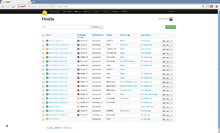Foreman (software)
Foreman (also known as The Foreman) is an open source complete life cycle systems management tool for provisioning, configuring and monitoring of physical and virtual servers. Foreman has deep integration to configuration management software, with Ansible, Puppet, Chef, Salt and other solutions through plugins, which allows users to automate repetitive tasks, deploy applications, and manage change to deployed servers.
 | |
 Foreman v1.2 Screenshot Hosts | |
| Original author(s) | Paul Kelly and Ohad Levy |
|---|---|
| Initial release | 10 September 2009[1] |
| Repository | |
| Written in | Ruby and JavaScript |
| Platform | Cross-platform: Unix, Linux, Microsoft Windows, OS X |
| Available in | English, French, German, Spanish |
| Type | Systems management |
| License | GPL |
| Website | www |
Foreman provides provisioning on bare-metal (through managed DHCP, DNS, TFTP, and PXE-based unattended installations), virtualization and cloud. Foreman provides comprehensive, auditable interaction facilities including a web frontend, a command line interface, and a robust REST API.
History
Initial development on Foreman started on July 2009 under a different project name. The initial release 0.1 was committed in September 2009[1] by Ohad Levy.
Availability
Foreman is targeted on Linux operating systems, but users reported successful installations on Microsoft Windows, BSD, and macOS.
The core Foreman team maintains repositories for various Linux distributions: Fedora, Red Hat Enterprise Linux (and derivatives such as CentOS), Debian, and Ubuntu.
Plugins
Foreman comes with freely available plugins to increase functionality. All plugins are available on Github.
Release history
| Date | Version | Changes and additions |
|---|---|---|
| October 14, 2013 | 1.3.0[2] | Improvements were made in the installation process, API, scalability, existing hosts mapping to compute resources, and more. A new official CLI. |
| January 30, 2014 | 1.4.0[3] | New compute profiles feature, improved plugin registration and web UI extensibility, Kerberos authentication support and new smart proxy features. |
| May 9, 2014 | 1.5.0[4] | Config groups feature for Puppet management, integration with FreeIPA, improved authorization system and image provisioning on oVirt, libvirt and VMware ESX. |
| September 11, 2014 | 1.6.0[5] | Plugin support for Foreman's Smart Proxy, new API version, support for LDAP or Kerberos groups. |
| December 2, 2014 | 1.7.0[6] | New features for Foreman's smart class matchers supplying data to Puppet, more advanced networking support and a build health checker. |
| April 28, 2015 | 1.8.0[7] | Networking user interface and improved provisioning support, new installer features and performance enhancements. |
| August 18, 2015 | 1.9.0[8] | User interface enhancements, improved logging, image provisioning and e-mail notifications. |
| December 23, 2015 | 1.10.0[9] | Various host management user interface enhancements, DNS plugin support in Foreman's Smart Proxy. |
| April 1, 2016 | 1.11.0[10] | Parameter management improvements, new Smart Proxy user interfaces, DHCP plugin support in the Smart Proxy. |
| July 8, 2016 | 1.12.0 | Puppet 4 support, New OS support (Ubuntu Xenial, Fedora 24) |
| October 5, 2016 | 1.13.0 | IPv6 addressing and partial orchestration support, Support for different PXE boot loaders for UEFI booting, ISC DHCP performance improvement, Compute resource enhancements, Facter structured facts support |
| January 16, 2017 | 1.14.0 | Automatic IPv6 addressing for hosts in compute resources, support for exporting templates and see help on how to create them, LDAP enhancements to support putting users in organizations/locations |
| May 12, 2017 | 1.15.0 | Default owner for new hosts, notifications drawer, templates and roles locking, import hosts that are in compute resources, SSH keys deployed differently depending on who creates the host. Many VMWare related fixes including performance and host editing. |
| November 30, 2017 | 1.16.0 | Netgroup LDAP authentication, Puppet 5 support, VMWare SCSI controllers with per-disk configuration, Plugin Role Locking |
| April 17, 2018 | 1.17.0 | HTTP proxy for outgoing requests, Vertical navigation, Host interfaces auditing, Warning for unsupported PXE loader combinations |
| July 19, 2018 | 1.18.0 | Template importing, RancherOS provisioning support, MTU support for subnets, breadcrumb navigation |
| August 31, 2018 | 1.19.0 | Ubuntu Bionic support, Support for logging to journald or syslog, Full cloud-init support for oVirt |
| November 18, 2018 | 1.20.0 | Report templates, Template rendering engine rewrite, FIPS compliance, UI improvements |
| March 1, 2019 | 1.21.0 | New Diff viewer, Huawei VRP support, Performance and stabilization |
| June 5, 2019 | 1.22.0 | Array, Boolean and other types support in Parameters, Compute resource libraries update, Graphql API, Smart Proxy Exposed Capabilities and Settings |
See also
- Ruby on Rails
- Puppet (software)
- Chef (software)
- Salt (software)
References
- "Initial tag in git".
- . Groups.google.com. Retrieved on 2013-10-14.
- . Groups.google.com. Retrieved on 2014-01-30.
- . Groups.google.com. Retrieved on 2014-01-30.
- . Groups.google.com. Retrieved on 2014-09-11.
- . Groups.google.com. Retrieved on 2014-12-02.
- . Groups.google.com. Retrieved on 2015-04-28.
- . Groups.google.com. Retrieved on 2015-08-18.
- . Groups.google.com. Retrieved on 2015-12-23.
- . Groups.google.com. Retrieved on 2016-04-01.